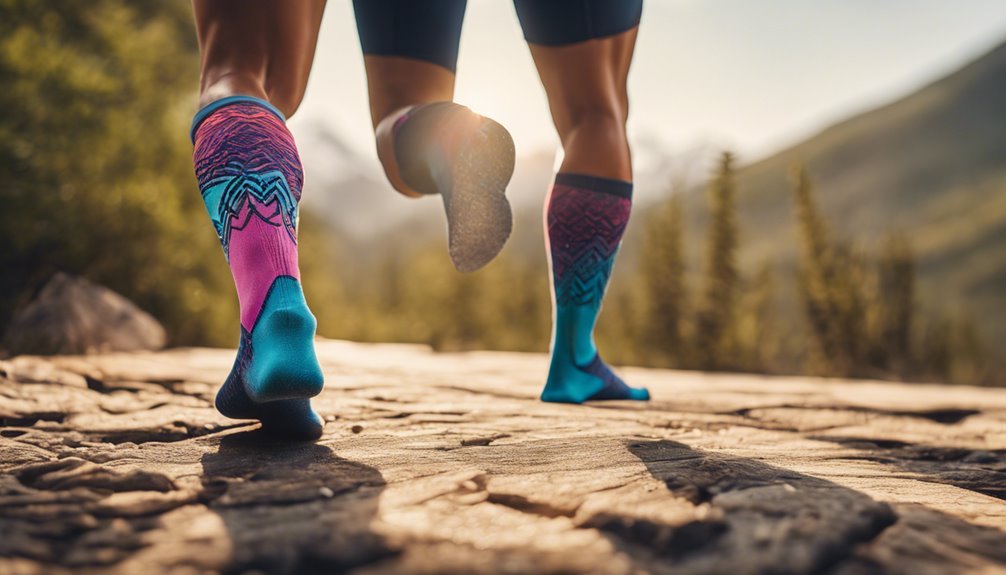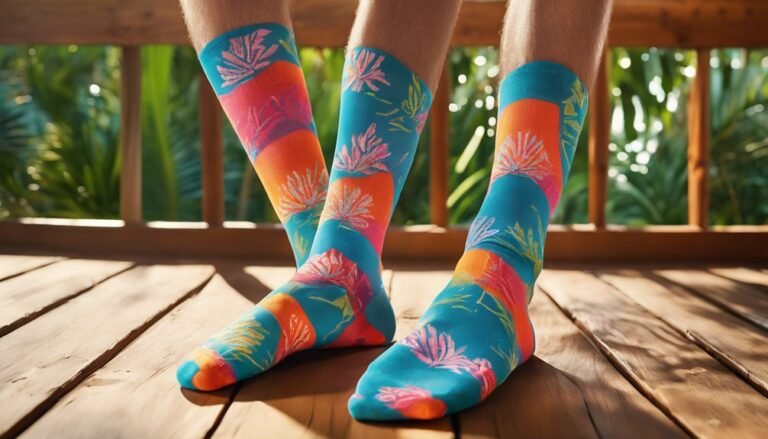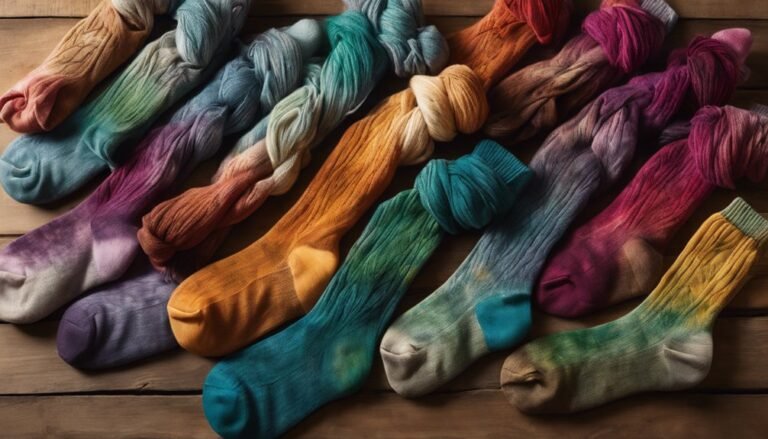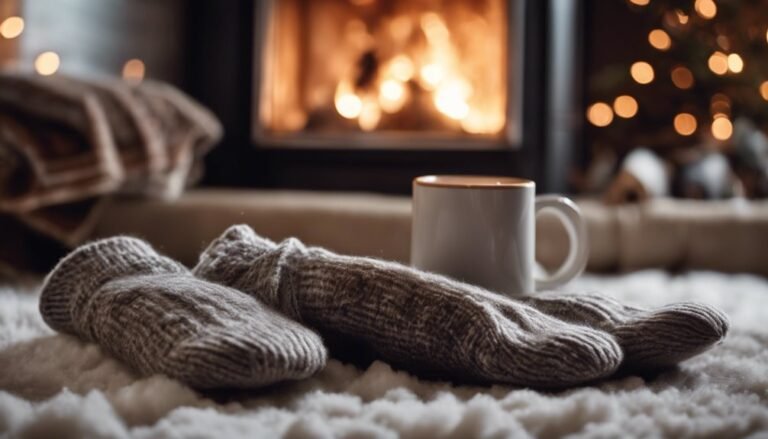Best Running Socks for Long-Distance Runners
Choosing the best running socks for long-distance running is essential for your comfort and performance. Look for moisture-wicking materials, good arch support, and a snug fit to prevent blisters and irritation. Consider the cushioning options that suit your preferences, whether dense padding for shock absorption or lighter styles for breathability. Brands like Balega and Darn Tough are popular for quality. By tailoring your sock choice to your running style, you can elevate your running experience even further.
Importance of Choosing the Right Running Socks
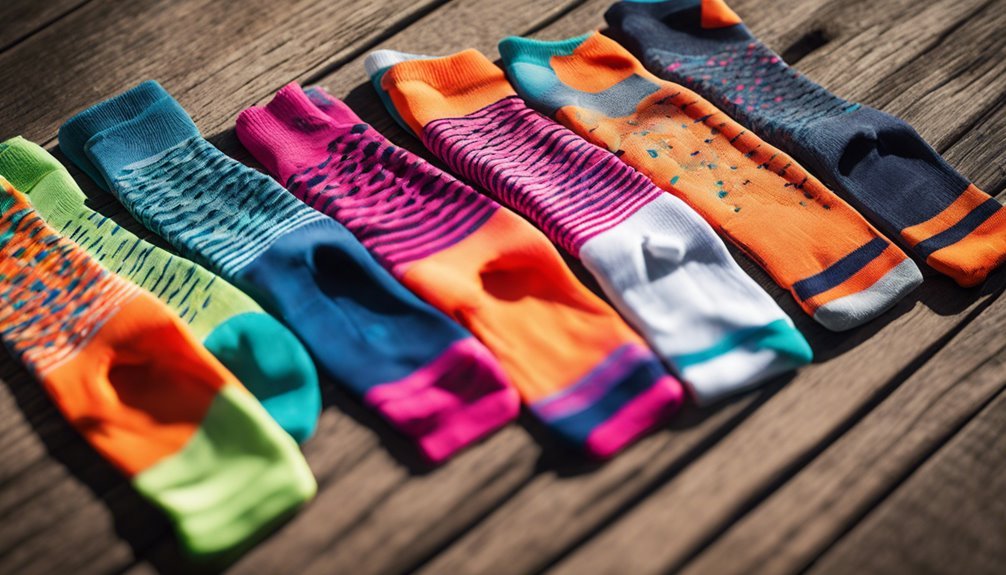
When it comes to long-distance running, the right pair of socks can make all the difference in your performance and comfort. Choosing the right sock materials is essential; they can either enhance your experience or hinder it. Materials like moisture-wicking polyester or merino wool help keep your feet dry, reducing the risk of blisters and discomfort during those long miles. Synthetic blends offer durability and elasticity, ensuring a snug fit that supports your foot's natural movement. If you want to maximize your running performance, you can't overlook the impact of your socks. A good pair can provide cushioning, breathability, and support, ultimately allowing you to focus on your stride and enjoy the freedom of the open road.
Key Features to Look for in Running Socks
Selecting the right running socks involves understanding the key features that can enhance your experience on the road. First, consider sock thickness; thicker socks often provide more cushioning, which can reduce fatigue on long runs, while thinner options promote breathability. Next, pay attention to arch support. Good arch support helps distribute pressure evenly across your feet, preventing discomfort during those extended miles. Additionally, look for moisture-wicking materials that keep your feet dry, reducing the chance of blisters. You'll also want a snug fit; socks that are too loose can bunch up, leading to irritation. With these features in mind, you'll find socks that not only feel great but also empower you to run longer and more comfortably.
Top Materials for Long-Distance Running Socks
When it comes to long-distance running socks, the materials you choose can make a significant difference in your comfort and performance. You'll want to look for moisture-wicking fabrics to keep your feet dry, breathable mesh panels for ventilation, and cushioning that provides support without adding bulk. Understanding these key elements will help you select socks that enhance your running experience.
Moisture-Wicking Fabrics
While you might be focused on finding the perfect pair of running shoes, don't underestimate the importance of moisture-wicking fabrics in your socks. These fabrics are essential for effective sweat management during long-distance runs. Materials like Merino wool, polyester, and nylon feature advanced fabric technology designed to pull moisture away from your skin, keeping your feet dry and comfortable. When your socks can efficiently manage sweat, you reduce the risk of blisters and discomfort that can hinder your performance. Look for socks that incorporate these moisture-wicking properties, as they'll enhance your overall running experience. Embracing these innovations lets you enjoy freedom in your stride, ensuring that your focus remains on the road ahead instead of your feet.
Breathable Mesh Panels
After ensuring your socks effectively wick away moisture, the next feature to contemplate is the inclusion of breathable mesh panels. These panels play a vital role in moisture management and temperature regulation, allowing your feet to breathe during those long runs. When you're pushing your limits, the last thing you want is sweaty, overheated feet. Breathable mesh enhances airflow, keeping your feet cooler and more comfortable, reducing the risk of blisters and discomfort. Look for socks with strategically placed mesh zones that provide ventilation without sacrificing durability. The right blend of materials will give you that freedom to focus on your run, knowing your feet are protected and able to perform at their best.
Cushioning and Support
Cushioning and support are essential factors in choosing the right socks for long-distance running, as they can greatly impact your comfort and performance. Look for materials that provide excellent arch support to help stabilize your feet during those long miles, reducing the risk of fatigue and injury. Additionally, heel cushioning is vital; it absorbs shock and offers a plush feel with every stride. Many top brands utilize advanced foam technologies or specialized padding in these areas, ensuring you feel supported without compromising breathability. Always consider the thickness and density of the cushioning, as it should align with your personal preferences and running style. With the right combination, you'll enhance your running experience, allowing you to focus on the freedom of the open road.
Best Cushioning Options for Comfort
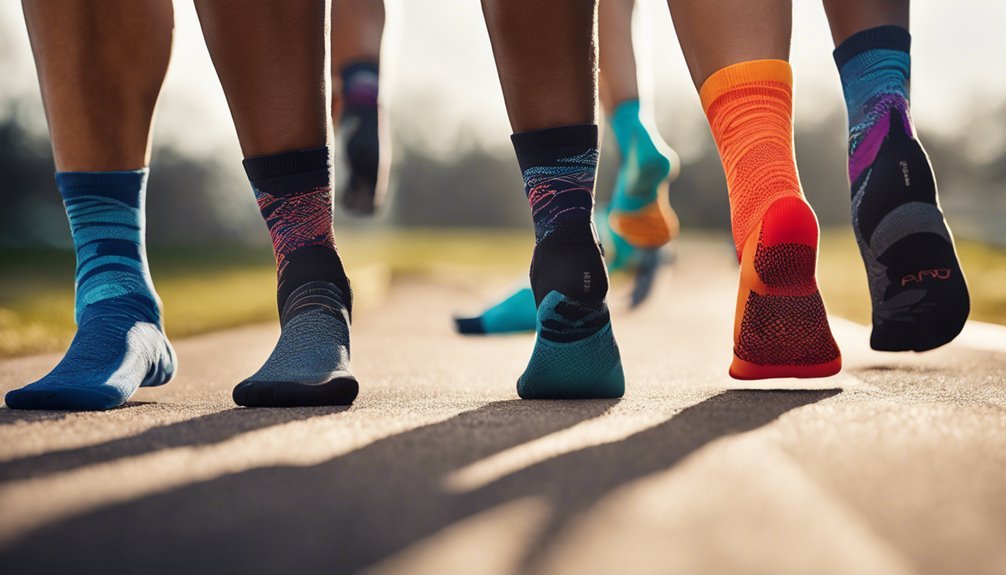
When you're pounding the pavement during those long runs, having the right cushioning in your socks can make all the difference in your comfort and performance. You'll want to evaluate various cushioning technologies and sock thickness to find what suits your needs best. Here are some options to explore:
- Dense Padding: Provides maximum comfort and shock absorption, great for longer distances.
- Targeted Cushioning: Offers support in key areas like the heel and ball of the foot, reducing fatigue.
- Lightweight Options: Minimal thickness with strategically placed cushioning for breathability while still offering protection.
Finding the right balance of cushioning can enhance your running experience, allowing you the freedom to focus on the road ahead.
Recommended Brands for Running Socks
While finding the perfect pair of running socks can feel overwhelming, several brands consistently stand out for their quality and performance. Brands like Balega and Darn Tough offer exceptional sock thickness comparison, catering to your preferred cushioning level. If you lean towards lightweight options, Feetures and Swiftwick are worth considering, while those who enjoy a bit more heft might appreciate the offerings from Smartwool.
Additionally, consider your color preference analysis. Many brands provide a variety of vibrant colors and patterns, allowing you to express your personality while maintaining functionality. Ultimately, testing a few pairs from these recommended brands can help you find the ideal balance between comfort, support, and style, ensuring your long-distance runs are as enjoyable as possible.
How to Care for Your Running Socks
Taking proper care of your running socks can greatly extend their lifespan and performance. You'll want to pay attention to washing techniques, drying methods, and even how you store them when they're not in use. By following these simple guidelines, you can keep your socks in top shape for those long miles ahead.
Washing Techniques for Longevity
To guarantee your running socks last through countless miles, adopting the right washing techniques is essential. Different sock colors and fabric blends can react uniquely to washing, so keep these tips in mind:
- Use cold water: This helps maintain the integrity of the fabric blends and prevents fading in color.
- Avoid fabric softeners: They can break down moisture-wicking properties, diminishing performance.
- Wash inside out: This protects the outer fibers and helps preserve sock color.
Proper Drying Methods
After you've washed your running socks with care, how you dry them plays a significant role in their longevity and performance. Using appropriate drying techniques is essential, as different sock materials react differently to heat and moisture. For instance, synthetic and merino wool socks thrive when air-dried, maintaining their shape and moisture-wicking properties. Avoid using a dryer, as high heat can damage elasticity and cause shrinkage. Instead, lay them flat or hang them in a well-ventilated area. If you're short on time, a low-heat setting can work, but keep it brief. Proper care in drying not only extends the life of your socks but also guarantees they perform at their best during your long runs.
Storage Tips for Socks
Proper storage is essential for maintaining the quality of your running socks. When you care for your socks properly, you guarantee they last longer and perform better. Here are some effective sock storage and organization methods to reflect upon:
- Roll, don't fold: Rolling your socks helps preserve elasticity and prevents creases.
- Use a dedicated drawer or box: Keep your running socks separate from everyday wear to avoid mix-ups and damage.
- Label storage containers: If you have multiple pairs, labeling can help you quickly find the socks you need for those long runs.
Tips for Preventing Blisters During Long Runs
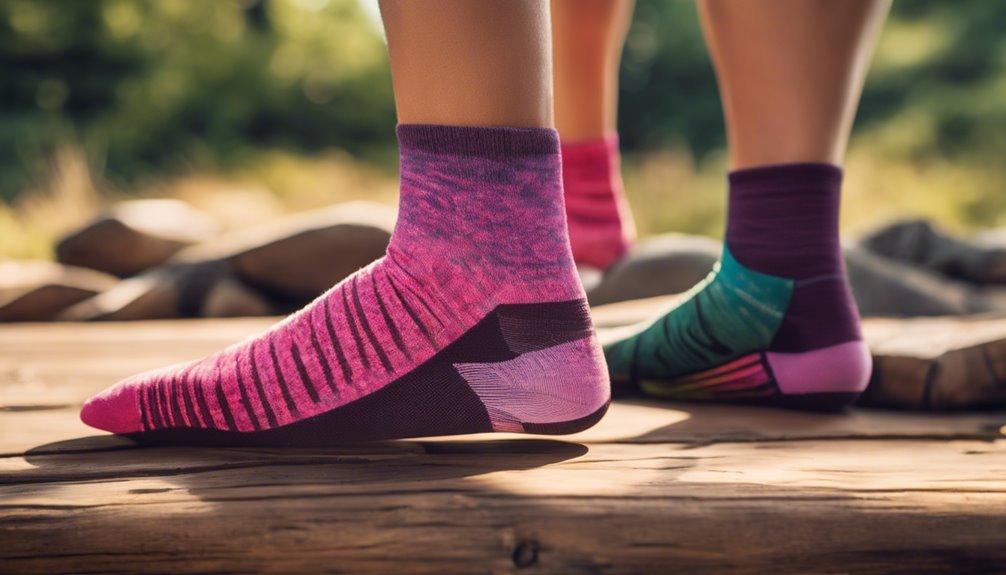
While you might be focused on building endurance during your long runs, preventing blisters should be just as much a priority. Here are some preventive measures to keep your feet blister-free:
| Preventive Measure | Description | Sock Adjustments |
|---|---|---|
| Choose the Right Socks | Opt for moisture-wicking fabric | Guarantee a snug fit |
| Use Lubricants | Apply anti-chafing creams | Target friction points |
| Maintain Foot Hygiene | Keep feet clean and dry | Change socks mid-run if needed |
Personalizing Your Sock Choice Based on Running Style
Choosing the right running socks can make a significant difference in your performance, especially when you reflect on your unique running style. Your sock fit can directly impact your comfort and efficiency, so it's essential to align your choice with your running technique.
Here are some factors to take into account:
- Foot Shape: If you have a wider foot, opt for socks with more stretch and room.
- Arch Support: Select socks that provide arch support tailored to your foot type.
- Cushioning Level: Depending on your running technique, you may prefer more or less cushioning.
Frequently Asked Questions
How Often Should I Replace My Running Socks?
You should replace your running socks every 300-500 miles, depending on sock materials and sock lifespan. Regular checks for wear and tear can help maintain comfort and performance, allowing you to enjoy your runs freely.
Can I Wear Regular Socks for Long-Distance Running?
While regular socks might seem sufficient, they often lack the essential sock material and moisture-wicking properties needed for long-distance running. You'll likely experience discomfort, blisters, and fatigue without specialized socks designed to support your journey.
What Is the Ideal Sock Height for Runners?
The ideal sock height for runners often depends on personal preference. Ankle height provides minimal coverage, while crew length offers more protection and warmth, making it essential to find what feels most comfortable for your runs.
Should I Size up My Running Socks?
You shouldn't size up your running socks unless they feel too tight. A proper sock fit enhances comfort and moisture management, preventing blisters during runs, so stick with your regular size for peak performance and freedom.
Do Running Socks Help With Temperature Regulation?
Yes, running socks can enhance temperature control and moisture management. They wick away sweat, keeping your feet dry and cool, which helps prevent overheating and blisters during your runs, allowing you the freedom to focus on performance.

